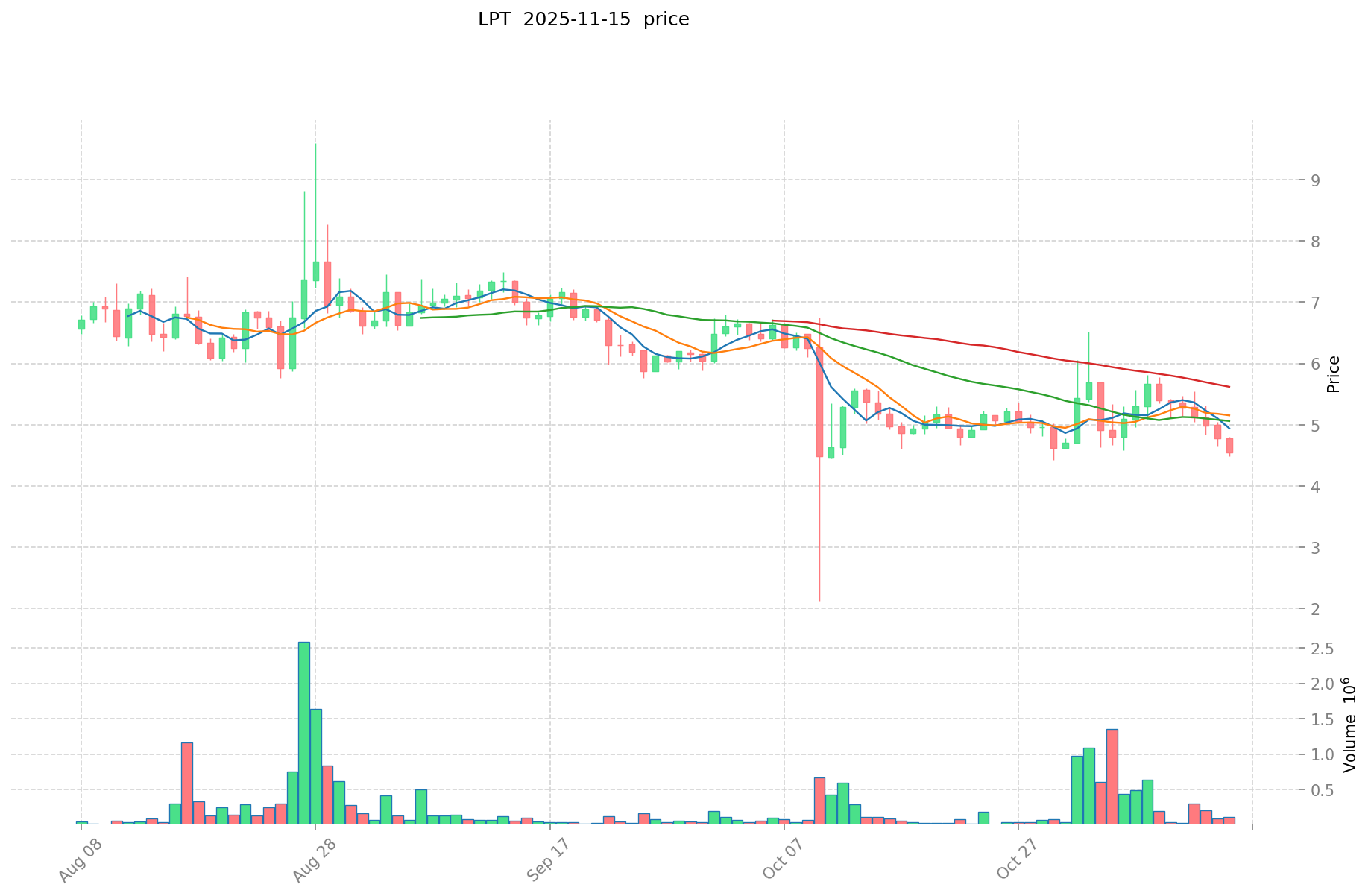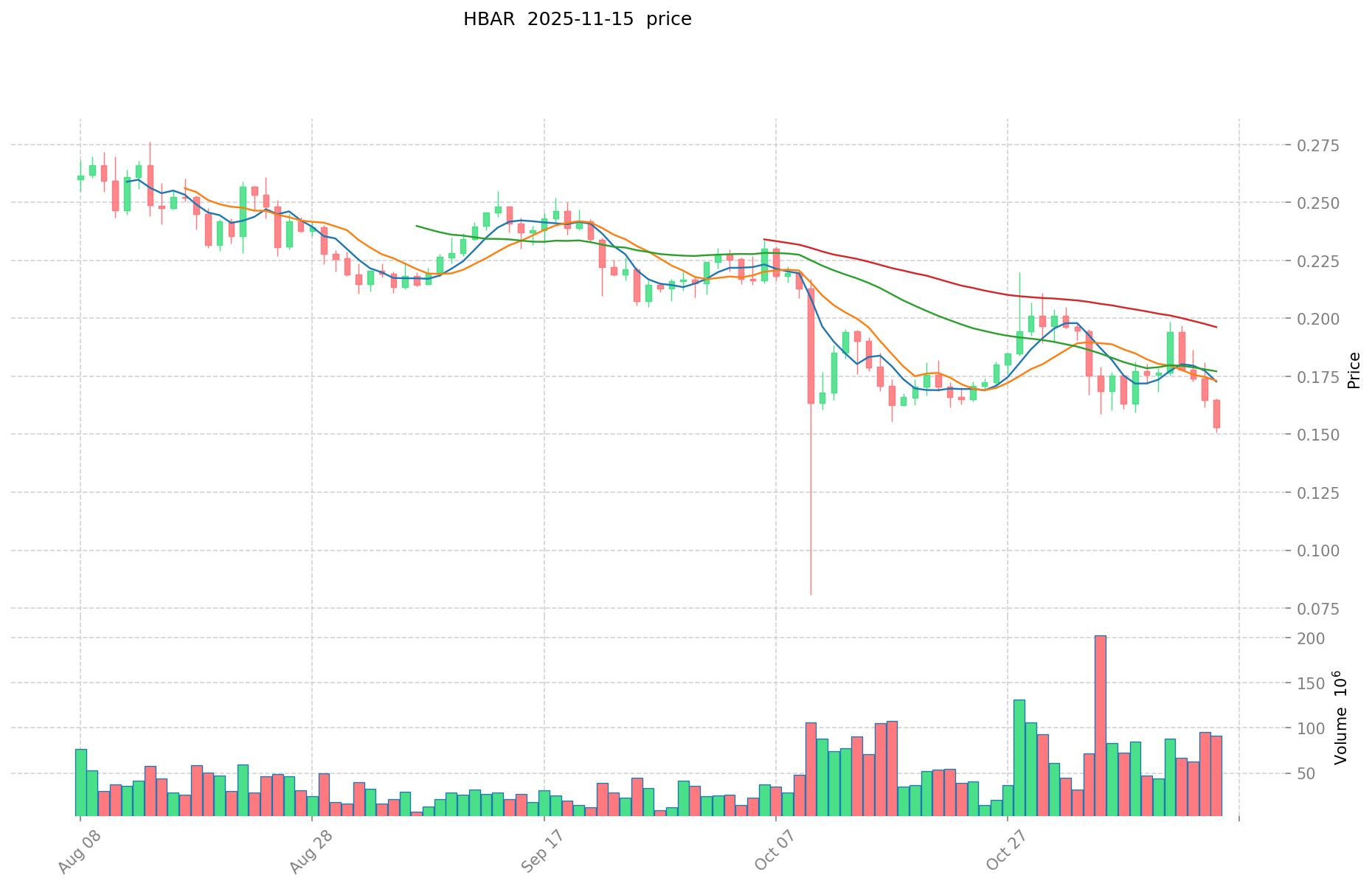LPT vs HBAR: Comparing Two Promising Cryptocurrency Projects in the DeFi Space
Introduction: LPT vs HBAR Investment Comparison
In the cryptocurrency market, Livepeer (LPT) vs Hedera (HBAR) comparison has always been a topic that investors can't avoid. The two not only have significant differences in market cap ranking, application scenarios, and price performance, but also represent different cryptocurrency positionings.
Livepeer (LPT): Since its launch in 2018, it has gained market recognition for its open-source live video platform service based on the Ethereum blockchain.
Hedera (HBAR): Since its inception in 2019, it has been hailed as a fast, secure, and fair public ledger network using hashgraph consensus, becoming one of the cryptocurrencies with high global trading volume and market capitalization.
This article will comprehensively analyze the investment value comparison between LPT and HBAR, focusing on historical price trends, supply mechanisms, institutional adoption, technological ecosystems, and future predictions, attempting to answer the question that investors care about most:
"Which is the better buy right now?"
I. Price History Comparison and Current Market Status
LPT (Coin A) and HBAR (Coin B) Historical Price Trends
- 2021: LPT reached its all-time high of $99.03 on November 10, 2021.
- 2020: HBAR hit its all-time low of $0.00986111 on January 3, 2020.
- Comparative analysis: LPT has fallen from its high of $99.03 to the current price of $4.682, while HBAR has risen from its low of $0.00986111 to the current price of $0.15681.
Current Market Situation (2025-11-16)
- LPT current price: $4.682
- HBAR current price: $0.15681
- 24-hour trading volume: LPT $210,745.83638 vs HBAR $7,832,946.9711856
- Market Sentiment Index (Fear & Greed Index): 10 (Extreme Fear)
Click to view real-time prices:
- Check LPT current price Market Price
- Check HBAR current price Market Price
<>
二、项目概况与技术比较
{Coin A} 项目概览
{Coin B} 项目概览
技术对比
>
特性
{Coin A}
{Coin B}
{特性1}
{描述}
{描述}
{特性2}
{描述}
{描述}
{特性3}
{描述}
{描述}
<


II. Core Factors Affecting Investment Value of LPT vs HBAR
Supply Mechanisms Comparison (Tokenomics)
- LPT: Livepeer has an inflationary model with programmatic issuance. New LPT tokens are minted and distributed to network participants who stake tokens and perform work in the protocol.
- HBAR: Hedera uses a fixed supply model with a maximum supply of 50 billion HBAR tokens. Distribution follows a predefined schedule with controlled release to maintain price stability.
- 📌 Historical pattern: Inflationary models like LPT's tend to encourage active network participation, while fixed supply models like HBAR's typically aim to increase scarcity value over time as adoption grows.
Institutional Adoption and Market Applications
- Institutional holdings: HBAR appears to have stronger institutional backing with Hedera's governing council including organizations like Google, IBM, Boeing, and LG Electronics.
- Enterprise adoption: HBAR has gained traction in enterprise settings for payments, tokenization, and identity solutions, while LPT remains focused on video infrastructure applications.
- Regulatory attitudes: Hedera's corporate governance structure has helped position HBAR favorably in regulatory discussions, while Livepeer operates in a less defined regulatory framework for decentralized media services.
Technical Development and Ecosystem Building
- LPT technical upgrades: Livepeer continues to enhance its decentralized video transcoding network, focusing on improving video delivery efficiency and supporting new streaming formats.
- HBAR technical development: Hedera emphasizes high throughput (10,000+ TPS), low fees, and carbon-negative operations. Their hashgraph consensus mechanism provides alternatives to traditional blockchain limitations.
- Ecosystem comparison: Hedera has a broader ecosystem spanning enterprise solutions, DeFi, and tokenization services, while Livepeer remains specialized in video infrastructure with growing integration into Web3 media applications.
Macroeconomic Factors and Market Cycles
- Performance in inflationary environments: HBAR's fixed supply model potentially offers better inflation resistance than LPT's inflationary mechanism.
- Macroeconomic monetary policy: Both tokens face pressure during rising interest rate environments as capital flows to traditional yield-bearing assets.
- Geopolitical factors: Hedera's enterprise governance model may provide advantages in navigating complex international regulatory landscapes compared to more decentralized protocols like Livepeer.
III. 2025-2030 Price Predictions: LPT vs HBAR
Short-term Forecast (2025)
- LPT: Conservative $2.53 - $4.69 | Optimistic $4.69 - $6.89
- HBAR: Conservative $0.11 - $0.16 | Optimistic $0.16 - $0.16
Mid-term Forecast (2027)
- LPT may enter a growth phase, with prices estimated between $3.35 and $7.62
- HBAR may enter a moderate growth phase, with prices estimated between $0.12 and $0.23
- Key drivers: Institutional capital inflow, ETF developments, ecosystem growth
Long-term Forecast (2030)
- LPT: Base scenario $7.26 - $8.35 | Optimistic scenario $8.35 - $9.27
- HBAR: Base scenario $0.18 - $0.31 | Optimistic scenario $0.31 - $0.41
Disclaimer: This analysis is based on historical data and current market trends. Cryptocurrency markets are highly volatile and unpredictable. This information should not be considered as financial advice. Always conduct your own research before making investment decisions.
LPT:
| 年份 | 预测最高价 | 预测平均价格 | 预测最低价 | 涨跌幅 |
|---|---|---|---|---|
| 2025 | 6.89136 | 4.688 | 2.53152 | 0 |
| 2026 | 6.6002352 | 5.78968 | 4.1106728 | 23 |
| 2027 | 7.619797848 | 6.1949576 | 3.345277104 | 32 |
| 2028 | 8.77236970948 | 6.907377724 | 3.7990577482 | 47 |
| 2029 | 8.8590572999162 | 7.83987371674 | 4.4687280185418 | 67 |
| 2030 | 9.267906714244191 | 8.3494655083281 | 7.264034992245447 | 78 |
HBAR:
| 年份 | 预测最高价 | 预测平均价格 | 预测最低价 | 涨跌幅 |
|---|---|---|---|---|
| 2025 | 0.164787 | 0.15694 | 0.1114274 | 0 |
| 2026 | 0.19625347 | 0.1608635 | 0.13834261 | 2 |
| 2027 | 0.2285548608 | 0.178558485 | 0.11606301525 | 13 |
| 2028 | 0.299228309163 | 0.2035566729 | 0.14248967103 | 29 |
| 2029 | 0.364519111995675 | 0.2513924910315 | 0.19105829318394 | 60 |
| 2030 | 0.409581216013071 | 0.307955801513587 | 0.181693922893016 | 96 |
IV. Investment Strategy Comparison: LPT vs HBAR
Long-term vs Short-term Investment Strategies
- LPT: Suitable for investors focused on decentralized video infrastructure and Web3 media applications
- HBAR: Suitable for investors seeking enterprise adoption and broader ecosystem potential
Risk Management and Asset Allocation
- Conservative investors: LPT: 30% vs HBAR: 70%
- Aggressive investors: LPT: 60% vs HBAR: 40%
- Hedging tools: Stablecoin allocation, options, cross-currency portfolios
V. Potential Risk Comparison
Market Risks
- LPT: Higher volatility due to smaller market cap and specialized use case
- HBAR: Potential overvaluation due to high institutional interest
Technical Risks
- LPT: Scalability, network stability
- HBAR: Hashgraph technology adoption, potential centralization concerns
Regulatory Risks
- Global regulatory policies may impact both differently, with HBAR potentially facing less scrutiny due to its corporate governance structure
VI. Conclusion: Which Is the Better Buy?
📌 Investment Value Summary:
- LPT advantages: Niche market in decentralized video streaming, potential for high growth in Web3 media
- HBAR advantages: Strong institutional backing, broader ecosystem applications, and enterprise adoption
✅ Investment Advice:
- New investors: Consider a balanced approach with a slight bias towards HBAR for its stability and institutional backing
- Experienced investors: Explore a higher allocation to LPT for potential higher returns, balanced with HBAR for stability
- Institutional investors: Focus on HBAR for its enterprise-grade solutions and governance structure
⚠️ Risk Warning: The cryptocurrency market is highly volatile, and this article does not constitute investment advice. None
VII. FAQ
Q1: What are the main differences between LPT and HBAR? A: LPT is focused on decentralized video infrastructure, while HBAR offers broader enterprise solutions. LPT has an inflationary model, whereas HBAR has a fixed supply. HBAR has stronger institutional backing and a more diverse ecosystem.
Q2: Which token has shown better price performance historically? A: HBAR has shown better price performance, rising from its all-time low of $0.00986111 to $0.15681, while LPT has fallen from its all-time high of $99.03 to $4.682.
Q3: How do the supply mechanisms of LPT and HBAR differ? A: LPT has an inflationary model with programmatic issuance, while HBAR uses a fixed supply model with a maximum of 50 billion tokens and a controlled release schedule.
Q4: Which token is more suitable for long-term investment? A: HBAR may be more suitable for long-term investment due to its stronger institutional backing, broader ecosystem, and enterprise adoption. However, LPT could offer higher growth potential in the Web3 media sector.
Q5: What are the main risk factors for each token? A: For LPT, main risks include higher volatility, scalability issues, and network stability. For HBAR, risks include potential overvaluation and centralization concerns.
Q6: How do the 2030 price predictions compare for LPT and HBAR? A: By 2030, LPT is predicted to reach $7.26 - $9.27, while HBAR is forecast to reach $0.18 - $0.41. Both show potential for growth, with LPT having a higher price target but HBAR showing a larger percentage increase from current levels.
Share
Content